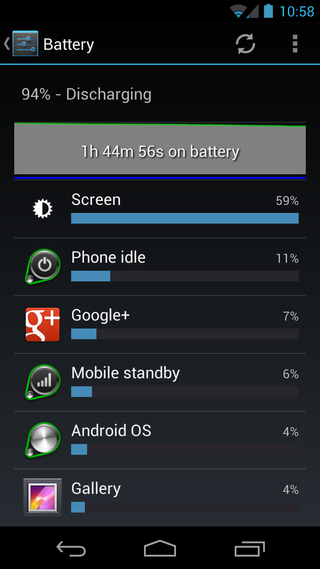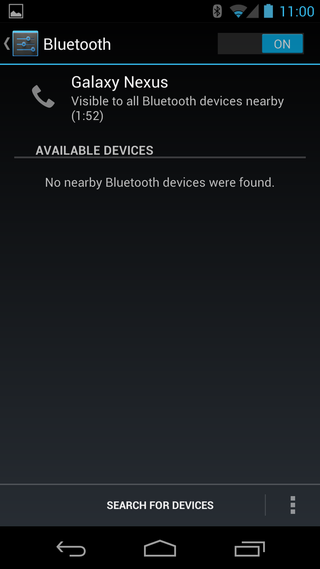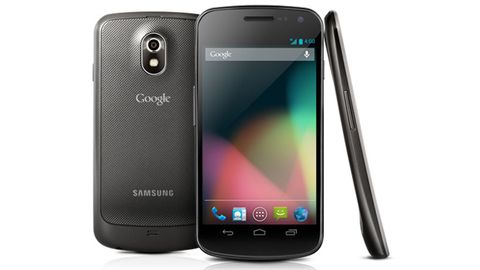Why you can trust TechRadar
Battery life
Samsung has done the honourable thing and kitted the Galaxy Nexus out with a decent battery. Yes, it sounds like we're being flippant, but considering how it's locked down the amount of storage, we wouldn't have been massively surprised to see a teeny, smurf-sized power pack in there.
1,750mAh actually sounds quite a lot - and it is a decent effort. Though it's a lot smaller than the Samsung Galaxy S3's at 2,100mAh, it's bigger than the Samsung Galaxy S2's, at 1,650mAh, and considering how we find that to be reasonable, we expected good things from the Samsung Galaxy Nexus.
Unfortunately, we were left a bit disappointed here. Although the Samsung Galaxy S2 and the Samsung Galaxy Nexus are roughly the same size, the screen on the Samsung Galaxy Nexus is bigger.
Not much, but enough to make a difference when it comes to eeking out the juice. Unfortunately, the display appears to always be the biggest drainer, and it is here.

The upshot is that if you don't use the Samsung Galaxy Nexus that much, then you'll be happy with the battery. We noticed about a 3% drain per hour when the phone was in standby, and that was with background sync running.
But as soon as you bring up that display, prepare to see battery go down up to 10% in 30 minutes - maybe more with the processor whirring away if you're using an app that needs a lot of power.
Using our standard battery test of a 90 minute video with full screen brightness and everything set to push notifications, the Samsung Galaxy Nexus went from full battery when we started to 68% by the end. If you're watching videos on the way to work and have a particularly long journey, you'll be screaming blue murder by lunchtime.
Samsung claim you'll get 500 minutes talk time over 3G and 270 hours of 3G standby time. While the standby time is reasonable we're not convinced that you'll get 270 hours with a 3G connection- maybe if you turn all push notifications off, but where's the fun in that?
Our advice is if you work in an office keep a USB cable handy, so at least you can get charging at your desk.
Connectivity
For connections, the Samsung Galaxy Nexus is pretty future-proof. Not only are the staples such as Bluetooth, Wi-Fi a/b/g/n, HSPDA (21 Mbps), HSUPA (5.76 Mbps) and GPS all built in, we also have the benefits of DLNA and NFC technology, which also incorporates Android Beam, plus you can set the handset up as a portable Wi-Fi hotspot.

As we've mentioned already in the Internet section of this review, you can expect blazing fast speeds over Wi-Fi and HSDPA, so internet surfing really is a breeze.
The Samsung Galaxy Nexus also provides you with a data monitor to track how much you get through, which is particularly handy on a data-hungry operating system like Android.
Wi-Fi is quick to set up, and Wi-Fi direct is also supported, so you can bypass the hotspot.
We weren't impressed with the wireless internet signal strength, though. Samsung really needs to sort out the components it uses, since we've noticed that on both the Samsung Galaxy Nexus and Samsung Galaxy S2, even when you're practically sitting on the router, it's still not 100%.
Apple iPhones and iPads and BlackBerry smartphones have no issue with our router, but Samsung does, and it irks when we can't use Wi-Fi at the other end of the house like we can with other manufacturers.

At least you can count on Bluetooth, which works like a trooper and is great for streaming music to compatible headsets and car stereos.
GPS was quicker than lightning to get a lock on, and even indoors away from a window, the chip put a valiant effort in, with Google Maps telling us where we were very quickly indeed.
Samsung has jumped on the NFC bandwagon and put a chip in the Galaxy Nexus to ensure that it is as future-proof as possible.
If you don't know what it's about, NFC enables you to use your phone as a wallet. You tap it against something and the money is taken automatically - a bit like an Oyster card for London transport. The technology has been around for years but it's only now that it's starting to get more coverage and implementation. With Google Wallet now a reality, you can see just how this will all fit together.
NFC also enables the exchange of data with the Android Beam service included. Basically, it means you can put your Galaxy Nexus next to another NFC-enabled phone and transfer things including contacts, photos, videos and songs just by touching. If you've ever heard of the iPhone Bump app, you'll be familiar with the concept.

Connecting the Samsung Galaxy Nexus to a PC is a breeze, it's basically just plug and play; letting you drag and drop things to and from the phone with ease.
Connecting to a Mac is a bit more of a chore. It's no longer a case of dragging and dropping like on older Android handsets. Now, you have to go and download the official Android Connectivity software or your phone just won't register as being connected.
Once it's downloaded, you basically get a glorified file manager, but you have to keep the Galaxy Nexus's screen turned on, otherwise it gets confused and the software stops sending. This is a real pain in the neck, and when transferring larger files like movies, it means you have to sit with the phone and virtually hold its hand.
Why they changed this on ICS, we don't understand. The Mac software also has the unfortunate accolade of being the first programme to crash our computer in at least a year.
James is a freelance phones, tablets and wearables writer and sub-editor at TechRadar. He has a love for everything ‘smart’, from watches to lights, and can often be found arguing with AI assistants or drowning in the latest apps. James also contributes to 3G.co.uk, 4G.co.uk and 5G.co.uk and has written for T3, Digital Camera World, Clarity Media and others, with work on the web, in print and on TV.


